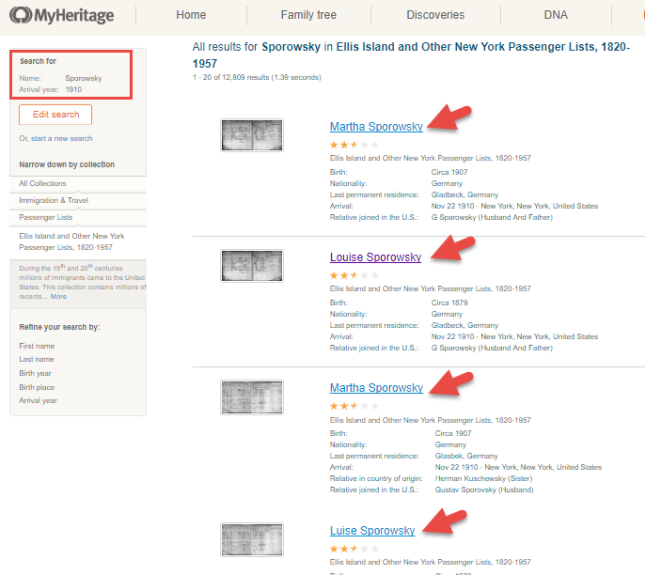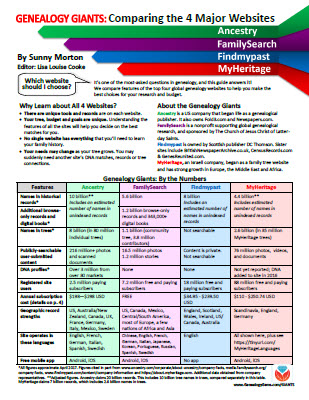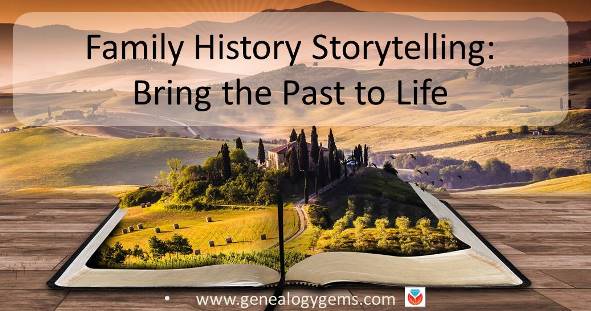Blog


Ellis Island Passenger Arrival Records: Relatives Now Searchable at MyHeritage
Millions of Ellis Island passenger arrival records include the names of the arrivals’ relatives, but those names haven’t been searchable in online indexes–until now. MyHeritage has added over 26.6 million relatives’ names to its passenger list collection and even digitally stitched together the pages for easier reading.

New Names in Ellis Island Passenger Arrival Records at MyHeritage.com
Recently, I interviewed Ellis Island experts and shared my ongoing immigrant ancestor discoveries in the free Genealogy Gems Podcast (episode 211) and Premium Podcast (episode 153). I’ve made progress by searching Ellis Island records at different websites and by learning about clues we often don’t recognize in the records themselves. So I was pleased to hear that MyHeritage has added its own Ellis Island and Other New York Passenger Lists (1820-1957) collection and given it two unique features:
- Its 94 million names include–for the very first time–26.6 million names of the relatives of passengers. Passenger lists recorded both the name of a relative or friend living at the arrival’s last residence and the name of a relative or friend the passenger was to visit in this country. Many times, this chain of names represents family links between an immigrant’s old and new homes. MyHeritage has indexed these names; their press release says they’re the first to do so. A quick check of Ellis Island collections at Ancestry.com, Ellis Island.org, Steve Morse’s One-Step Pages and FamilySearch confirms that none of them mention relatives’ names in their index descriptions.
- MyHeritage has stitched together the two-age passenger manifest images, which I find pretty cool. It’s much easier not to miss the fact that there is a second page for each record, and to trace your ancestor’s line straight across the page. Here’s what it looks like:

Searching for Ellis Island Immigrant Ancestors

Louise (on the right) just before departure for America.
Interestingly, this search engine is the first one of any genealogy records site to pull up both sets of arrival listings for my great grandmother Louise Sporowsky and her daughter Martha, whom I talked about in Genealogy Gems Premium Podcast Episode #153.
I’m very fortunate that by a quirk of circumstance Louise and Martha were recorded twice in the same passenger list. But because each entry had variations, they’ve never come up in the same search – that is until now!
The search was a simple one: the name “Sporowksy” & 1910 as the year of arrival:

Premium Members may listen to that episode to find out why Louise and Martha had two passenger listings for the same crossing and what I learned from looking at both of them.
Here’s a tip: There isn’t a separate search field for relatives’ names in the MyHeritage index. I wondered about that, and Daniel Horowitz at MyHeritage confirms that you just use the regular search fields for first and last names of the passenger’s relatives. Results will include both the passengers themselves and the relatives they named.
Learn More about Ellis Island
Listen to the free Genealogy Gems Podcast episode #211: Barry Moreno, Historian at Ellis Island, talks about the life cycle of this busy U.S. immigration station (1892-1954) and his research into the lives of Ellis Island employees.
Disclosure: This article contains affiliate links and Genealogy Gems will be compensated if you make a purchase after clicking on these links (at no additional cost to you). Thank you for supporting Genealogy Gems!

Why You Should Have a Free FamilySearch Account–And Use It!
A free FamilySearch account gives you access to more historical records and customized site features than you’ll see if you don’t log in at this free genealogy website. Here’s why you should get a free FamilySearch account and log in EVERY time you visit the site.
This post is part of our ongoing commitment to help you get the most out of the “Genealogy Giants:”

In this post, I comment on a recent announcement from the free giant everyone should be using: FamilySearch.org.
Why you should have (and use!) a free FamilySearch account
FamilySearch.org has always allowed free public use of its site. But beginning on December 13, 2017, the site will now actively prompt visitors to register for a free FamilySearch account or to log in with their existing accounts. Anyone can continue to search the catalog and user-submitted genealogies, explore over 350,000 digitized books, learn from the Wiki and the learning center, and even view user-contributed photos and stories. But by requesting you to log in, FamilySearch wants to remind you that this is your path to even more free records and services on the site.
Here are my top three reasons to have and use a free FamilySearch account:
1. Access more free historical records on FamilySearch.
We’ve talked a lot in recent months about best strategies for accessing digitized and off-line historical records at FamilySearch. Some of the digitized records on FamilySearch are there courtesy of a partner organization, which may restrict record access to those who log in on the site.
One woman had an “ah-ha” moment of realization after reading FamilySearch’s announcement. She posted in the comments, “Though I have had a free account for some time, I did not realize that FamilySearch was not giving me full access to information in record searches just because I had not logged in. Maybe I need to redo my past searches as a logged-in account holder.”
2. Participate in the global Family Tree.
As I more fully describe in my quick reference guide, Genealogy Giants: Comparing the 4 Major Websites, FamilySearch’s online family tree is different than the tree systems used at the other major family history websites. Instead of creating your own personal tree, you participate in a collaborative, unified family tree of the world. As a logged-in visitor, you can enter your information, then that of your parents and their parents, etc. until you connect to deceased individuals who are already on the tree. (Information about living individuals is always privacy-protected.) Then you may, with other descendants, contribute what you to know to an ancestor’s profile.
Anyone may make changes to these public profiles, which may at times be frustrating. But it also allows for more focused collaboration. This is a great place to see a virtual compilation of others’ research on particular ancestors without having to search others’ personal trees individually, as you do on other sites (remember to look for their source citations and verify what others say). The Family Tree on FamilySearch is also a great place to digitally archive family documents and photos where other researchers may see and appreciate them for free. As you can see in the screenshot below, logging in also helps you see how others have identified the folks you see in your search results:

3. Get customized help.
Those who log in with a free FamilySearch account have access to one-on-one assistance through the website. If you have a question about using the site, accessing records, finding additional records about your ancestors, or even how to understand the records you’re looking at, you can email or call a live support person for help. Your login also sets you up to receive customized alerts and seasonal messages (like “Did you know your ancestor fought in the War of 1812?”) and a dashboard experience with at-a-glance reminders of record hints awaiting your review, where you left off in your last online session, tips about what to do next, and more. Here’s what the dashboard looks like:

How to get (or recover) a free FamilySearch account
See Registering to use FamilySearch.org for information about creating a free account. FamilySearch accounts have always been free and, the site assures us, will continue to be free. You will need to provide your first and last name, a username, a password, and an email or mobile phone number.
According to FamilySearch, your login and other personal information:
- enables collaboration in the Family Tree and Memories areas of the site (you control how much information is shared)
- “allows you to send in-system messages to other users without revealing your personal identity or email address”
- “allows FamilySearch to send you emails and newsletters (you can specify how many emails, if any, you receive)”
- enables communication when you contact their online support team for help
- will not be shared “with any third party without your consent”
If you’ve already got a FamilySearch account but have forgotten your username, click here. If you’ve forgotten your password, click here.
Genealogy Gems Brings You Genealogy Giants
 Each of the “Genealogy Giants” has so much to offer family historians around the world! But it’s hard to keep them straight, compare their top features, and get the most out of them without some inside help. That’s why we published the must-have quick reference guide, Genealogy Giants: Comparing the 4 Major Websites, your personal comparative tour of Ancestry.com, FamilySearch, Findmypast, and MyHeritage.
Each of the “Genealogy Giants” has so much to offer family historians around the world! But it’s hard to keep them straight, compare their top features, and get the most out of them without some inside help. That’s why we published the must-have quick reference guide, Genealogy Giants: Comparing the 4 Major Websites, your personal comparative tour of Ancestry.com, FamilySearch, Findmypast, and MyHeritage.
This inexpensive guide can save you hours of wasted time hunting down the records you need. It can save you hundreds of dollars by helping you invest in the genealogy websites you most need to use right now–because your research needs change right along with your growing family tree! The guide is available for your immediate reference as a digital download or get a handy, high-quality printed copy you can keep with your genealogy research files.

About the Author: Sunny Morton
Sunny is a Contributing Editor at Lisa Louise Cooke’s Genealogy Gems; her voice is often heard on the Genealogy Gems Podcast and Premium Podcasts. She’s known for her expertise on the world’s biggest family history websites (she’s the author of Genealogy Giants: Comparing the 4 Major Websites); writing personal and family histories (she also wrote Story of My Life: A Workbook for Preserving Your Legacy); and sharing her favorite reads for the Genealogy Gems Book Club.
Disclosure: This article contains affiliate links and Genealogy Gems will be compensated if you make a purchase after clicking on these links (at no additional cost to you). Thank you for supporting Genealogy Gems!

Photo + Story Competition: RootsTech 2018 Contest
A new Photo + Story competition will be part of RootsTech 2018! If you can take a story-filled picture and caption it meaningfully, you should enter. Check out these tips for creating winning family history photo and story combinations. Winners will receive prizes from Canon and Dell–so start putting together your best photos and stories.

RootsTech 2018 Photo + Story Competition
“A good photo tells a good story. And behind every good photo and story is a photographer who recognized the moment the two had come together and snapped the shutter.” So says the press release announcing RootsTech 2018‘s Photo + Story Competition. Here’s how to enter:
“Participate by finding or capturing a photo and story, past or present, of you or a family member. Unlike standalone photo or story competitions, we want you to use the power of both photo and story to share, persuade, inform, inspire, connect, and belong.” In fact, some of those verbs are the four categories in the competition:
- Connect
- Belong
- Family
- Heritage
Winners will awarded prizes from Canon and Dell, which will certainly help your future family history storytelling! Selected entries will appear in an exhibit at RootsTech 2018.
 This contest complements the appearance of RootsTech 2018 keynote speaker Humans of New York photographer Brandon Stanton. His personal glimpses into the lives of ordinary people in New York has set a standard for quality photo stories.
This contest complements the appearance of RootsTech 2018 keynote speaker Humans of New York photographer Brandon Stanton. His personal glimpses into the lives of ordinary people in New York has set a standard for quality photo stories.
Details You’ll Want to Know
Here are several must-know details if you’d like to enter the contest–or encourage someone you know to enter:
- Entrants can submit one photo and story in each of the categories.
- Entrants must be at least 18 to apply.
- No professional qualification, licenses, certificates, or certification is required.
- If you didn’t take the picture, you must have permission or rights to use the photo (if it was taken after 1923). Agreeing to compete places full liability on the participant.
- Go to RootsTech.org for contest entry details.
- The deadline for entries is December 31, 2017.
- Selected entries will be notified by January 15, 2018, with more information on their intent to exhibit.
Family History Storytelling Tips for You
At Genealogy Gems, we’re all about helping you to discover, preserve and share your family history. If you’re thinking of entering this contest, consider how the following tips, adapted from a Genealogy Gems article on family history storytelling, can help your Photo + Story competition entry:
- Create vivid “characters.” Photos can capturing someone’s expressions, body language, mood, unique clothing or a moment of intense personal drama. They can also create compelling portraits of the heirlooms or objects that store family memories. Your stories can do the same. Choose unique, meaningful details–both in words and pictures.
- Paint the backdrop. What’s going on in the background of your picture? The “setting” and any background action should help tell the story, not distract from it. In your story, add essential details that the image can’t communicate. Is the exact date or place important? What else?
- Tell why this story matters. Call it what you will: a meaning, a moral, a message–the best stories and photos say something about life. Something more than skin deep. Think about why the picture and story matter to you. Share it clearly, concisely, with humor or feeling or whatever tone best works for you and the message.
Genealogy Gems will be at RootsTech 2018 to help you discover and share your family stories! Click here to learn more.







